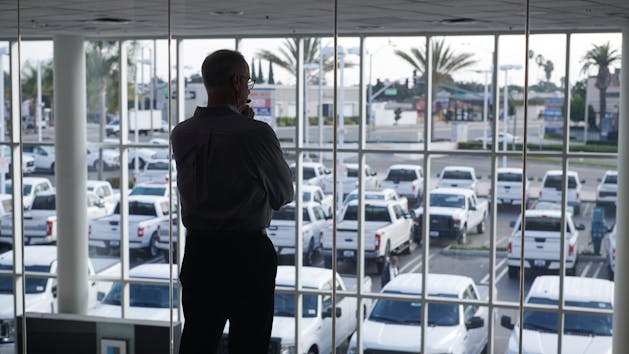Find the right solution for your business with our free Fleet Management Buyer’s Guide.
How Do Construction Companies Use GPS Tracking?
When we think of GPS, we generally think of portable devices found on the dashboard of a vehicle, guiding the driver with turn-by-turn directions.
But navigation is only one aspect of GPS.
GPS is an extremely valuable business tool for construction companies that helps them manage expensive machinery, from towers and mobile cranes to earth moving equipment, service vehicles and heavy trucks. In fact, it is often used for all types of assets that are worth tracking, such as generators and compressors.
How is an asset tracked using GPS?
So how exactly does an asset get tracked? Here's an overview of what's involved:
- A small GPS tracking device is installed on the asset (a process which usually takes about 15 minutes). These tracking devices are generally very rugged and sealed from the elements. They can handle a wide range of temperatures and rough working conditions. In most cases the GPS device will use the equipment's power source; however, it can be set up to use its own power source, such as a battery that can last up to seven years.
- The tracking device is wired into the equipment (where applicable) so information such as when the engine is started or stopped can be tracked. There is no limit to the different equipment metrics you could monitor — as long as it's a wiring system that the tracking device can connect to. Even old equipment can be fitted with GPS tracking devices.
- The device is registered with a GPS tracking program such as Verizon Connect Fleet™. Information that identifies the device is recorded so the right signals are matched to the correct piece of equipment.
- The device will transmit status updates when certain events are triggered (such as starting the engine) as well as location updates at regular intervals (normally every 2 minutes).
- The equipment appears on the dashboard of the GPS tracking software (Verizon Connect Fleet) showing its location and current status (e.g., idle, off-duty, moving, etc.)
How does a fleet manager use the tracking information?
Obviously, if a fleet manager is overseeing a large number of assets, reading every status update for every piece of equipment would take a ridiculously long time while accomplishing very little. This is where Verizon Connect Fleet can make sense of the huge amount of data being generated by a fleet of GPS tracked assets.
Verizon Connect Fleet has a one-screen dashboard that pinpoints all the assets on a map. From there, a manager can zoom in on a particular asset for more detail or to communicate with the operator.
Another way to make sure that fleet managers only see GPS data that's relevant to them is to configure customized business rules. Here are a few examples showing how exceptions and customized alerts make sense of the huge amount of GPS tracking data that is collected.
Hours of service
Legislation may require that a crane operator can only work for a maximum of 10 hours a day. Verizon Connect allows operators to record start and stop times, signing off on their hours of service. A crane operator digitally signs on to the GPS device in the cab when they finish their shift, providing managers with details on hours the operator has worked, including any breaks. This allows you to make sure your crane operators are complying with relevant HOS rules and keeping your site legal.
Any exceptions to this are highlighted on the Verizon Connect Fleet dashboard and management reports for easy review.
Safe driving speeds
Some forklifts become dangerous when driven over a certain speed. A fleet manager needs to know if they are being driven dangerously so workers can be given appropriate training to minimize the company's liability and protect its safety record.
A customized alert can be set up for a specific vehicle and an email sent when there is a speeding incident. For fleet managers on the move these messages can be sent to an iPhone or other connected device.
Complying with construction working hours
You have a contract to construct a new building in a remote city. Your company is required by local city laws to only work at certain times and days to avoid disrupting the local residents. It's very important for your firm to comply with these requirements to avoid bad publicity, costly fines and increase the chance of future work in the area.
While the city is located several hundred miles away you want to monitor the fleet's activity closely to make sure they are complying with the city's requirements. In Verizon Connect Fleet, you group all the vehicles, machinery and other equipment operating on the site that are required to adhere to the allowable working hours into a single team.
You can then configure a single alert for the whole team that notifies you whenever any equipment in this team is being operated outside of the allowed hours, so you can contact the foreman for an explanation.
Past, present and future fleet management
These examples show how heavy equipment can be GPS tracked to make management easier. And the benefits don't just include the ability to monitor equipment to make sure fleet operators are complying with business rules and that equipment is secure from unauthorized use.
GPS tracking provides historical data as well, which can assist with accurate billing and timesheet verification or better warranty recovery.
Data can also be used for future planning, including costing new jobs or planning work schedules. Use it to keep track of maintenance or get notifications when insurance or licenses need renewing.
Accurate, reliable, and designed for heavy equipment management
Verizon Connect has valuable know-how and experience in tracking remote and mobile fleet assets. A wide range of equipment can be monitored and managed, including older machines that can be retrofitted with GPS technology and tracking.
For fleet managers, having that sort of control over their heavy equipment means peace of mind, and it's hard to put a price on that.
Find out how our platform gives you the visibility you need to get more done.




